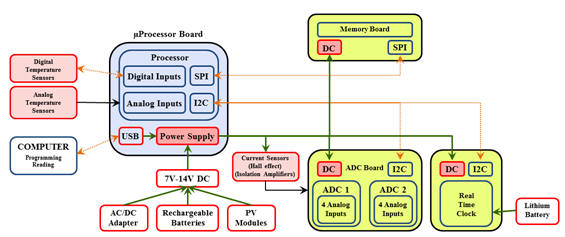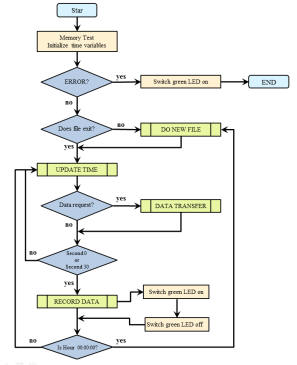![]()
![]()
'Better to fight for something than live for nothing' George S. Patton
Projects with Arduino UNO: Low cost dataloggers.
A new data logger using the Arduino open-source electronic platform has been developed to solve the current problem of monitoring photovoltaic (PV) systems at low-cost, especially in remote areas or regions in developing countries.
The data logger meets all of the relevant requirements in terms of accuracy included in the International Electrotechnical Commission (IEC) standards for PV systems, with a resolution of 18-bits, including 8 analogue inputs for measuring up to 8 PV modules and/or weather sensors, 3 inputs for low-cost analogue temperature sensors and virtually unlimited inputs for digital temperature sensors. The new data logger is completely autonomous, and the prototype has achieved an initial cost of only 60 . It was tested during a 6-month period under the harsh environmental conditions of the summer and winter in Southern Spain. The results using both the sensors and silicon reference cells indicate that the new system is reliable and exhibits comparable performance to commercial systems. This data logger is of special interest for both solar energy research and applications in developing countries, as it is both open-source and flexible. The data logger can be customised for the specific needs of each project at low-cost.
The main objective was to develop a datalogger with the following characteristics: (a) low-cost, using easily obtained hardware and frees oftware; (b) autonomous operation with low energy consumption and not dependent on a computer or access to a powergrid; (c) easy-to-build and handle; (d) high accuracy and meeting International Electrotechnical Commission (IEC) standards (specifically IEC61724
[1] and its normative references); (e) efficient data acquisition; (f)data-file creation capability; (g) robust when used in a harsh environment (i.e., outdoors); and(h) flexibility to be easily adapted to different PV applications by implementing a few changes (for example, allowing the number and type of input channels to be modified).
The article is accesible in the following link:
http://www.sciencedirect.com/science/article/pii/S0927024814004310
and Supplementary data associated with this article can be found in the on line version at http://dx.doi.org/10.1016/j.solmat.2014.08.008.
The details of the specific design and its implementation are described in this web.
The software for the data acquisition system has been developed taking advantage of all libraries previously prepared to use the software in the easiest way. Once the data logger starts appropriately, the program consists of a loop that reads the time, check the time interval to record the data and create a new file when the current day ends. Every time that the data are recorded the green LED switch on several seconds to indicate the software runs right. The time interval has been determined according to IEC61724 (below a minute). That is the reason to use 30 seconds (new intervals can be programmed) as sampling interval, coinciding with second 0 and 30 of every minute.
Above the detail of the flowchart from the main program is shown. The user cannot change the initial configuration when the data logger is working. It demands the user must know the program perfectly if changes want to be done.

Libraries used: (arduino.cc/en/pmwiki.php?n=Reference/Libraries)
- SD.h arduino.cc/en/pmwiki.php?n=Reference/SD
- Wire.h arduino.cc/en/pmwiki.php?n=Reference/Wire
- Time.h playground.arduino.cc/Code/Time
- MCP3424.h https://github.com/codebendercc/arduino-library-files/blod/master/external -libraries/MCP3424/MCP3424.h
- OneWire.h playground.arduino.cc/Learning/OneWire
![]()
© Universidad de Jaén. Página mantenida por
mfuentes![]()
Última actualización: 15 diciembre 2014